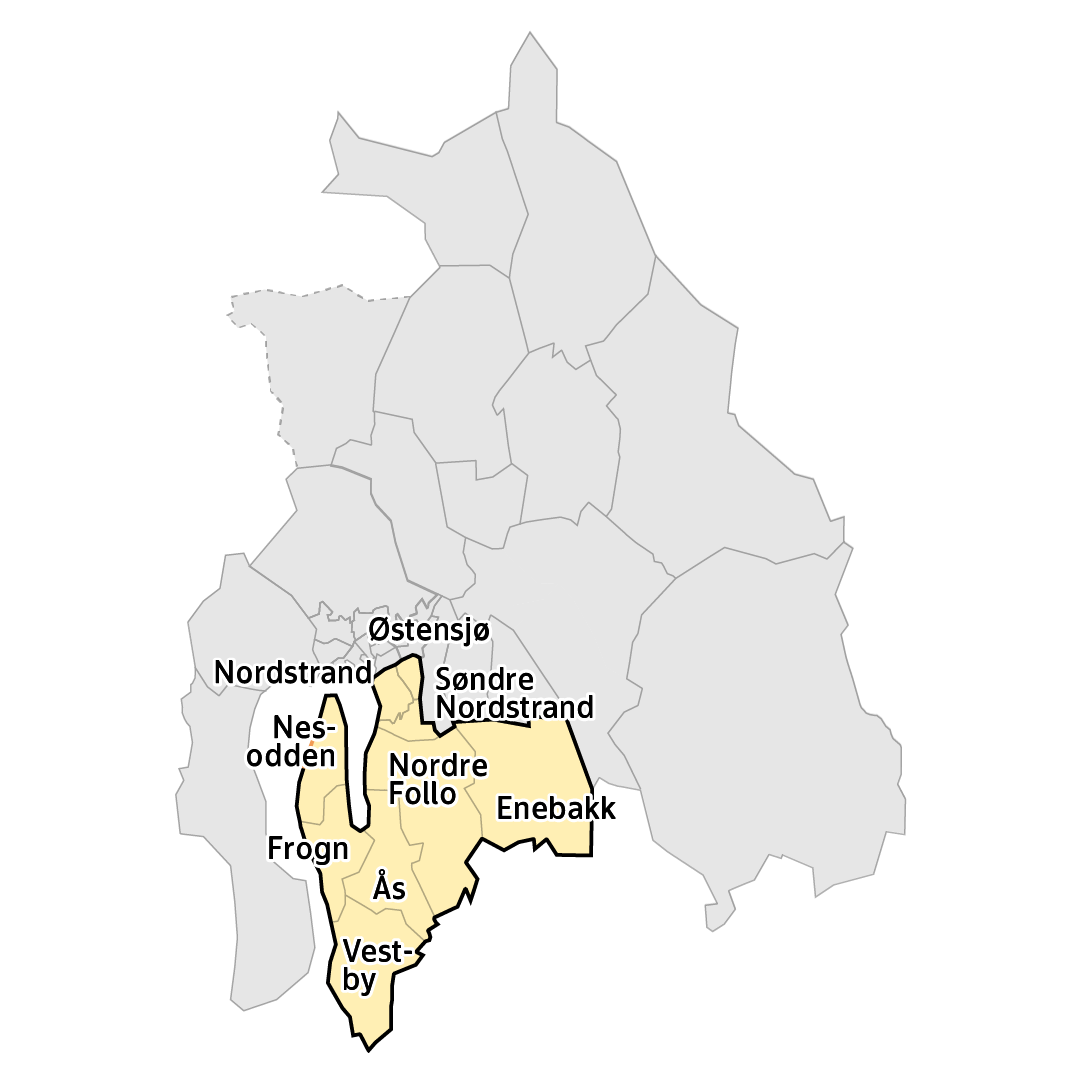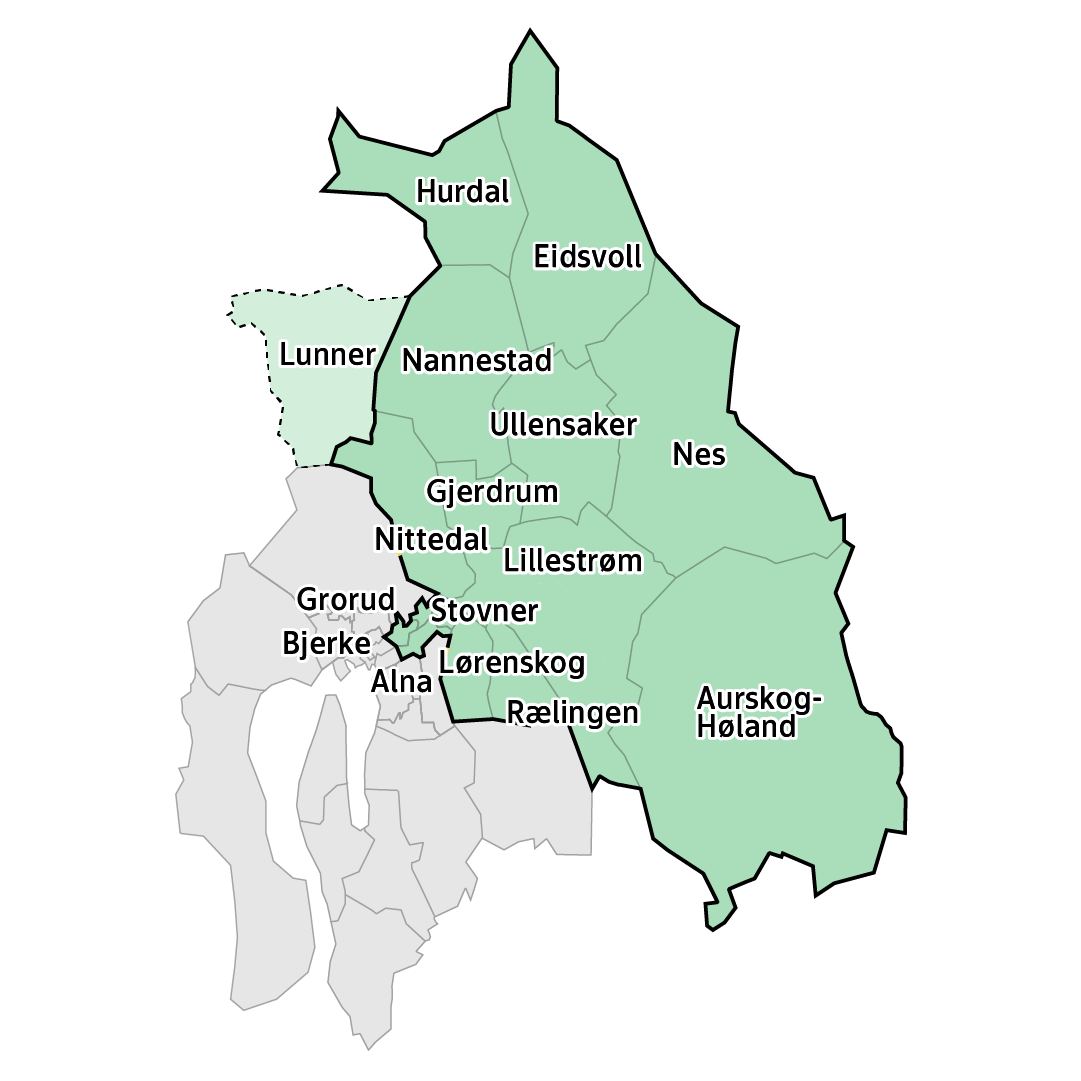
Market areas
Ruter is organized in four market areas to ensure site-specific solutions and a thorough understanding of our customers' local needs. This market division provides greater proximity to our customers and other affected parties, and to address political issues. In 2020, the corona pandemic affected the use of public transport severely, but to varying degrees in the various market areas.
The city centre is the hub of the public transport system. In 2020, there were far fewer business and leisure travellers coming from the surrounding market areas. However, traffic has fallen most in the market area West, while in the Northeast and South there has been a lower customer dropout. These two areas have also had a faster recovery rate in periods when coronary restrictions have not been as strong. Common to all areas, however, is that ticket revenues have fallen sharply – due to fewer trips, but also due to a lower payment share.
In 2020, a new contract was entered into for bus services in Oslo south, and this agreement follows up Ruter’s ambition for emission-free public transport. The agreement means that there will be 109 new electric buses that will operate in the districts of Oslo south and parts of Nordre Follo. The contract will start in 2022, when almost the entire bus fleet will be emission-free.
During 2020, a number of changes were made to the tram services that serve the Nordstrand district. The trams running to the district were affected by major development projects that are part of street upgrades and infrastructure improvements until the new trams arrive. As of today, none of the lines from Nordstrand have a connection to the northern part of the tram network, but this will be restored when the Storgata project is completed in 2021.
An exciting project in this market area has been to test a small self-driving bus on Route 85B at Nedre Bekkelaget. The line served as a supplement to existing lines. The test was conducted from December 2019 to December 2020.
Such tests are important for developing the sustainable mobility of the future. Pilot Oppegård, a pilot project for transport booking, is another example of testing done in market area South. This test will provide more insight into customer needs, attractiveness, technology and the operation of flexible transport services. You can read more about the Nedre Bekkelaget and in Oppegård pilot projects under the chapter on Mobility Services.
The work to electrify the Nesodden boats was completed in May. In less than a year, the three vessels Kongen, Dronningen and Prinsen have been rebuilt from operating on liquefied natural gas to electricity, so all departures on all connections are now emission-free.

The Vålereng tunnel closed for rehabilitation in the spring of 2020, and this closure meant that Ruter had to reroute a number of bus routes from the northeast area. Some lines ran to the Helsfyr end stop, and a couple of lines also had to run through the streets of Old Oslo. The buses that were given a temporary route on the street network will be moved to the tunnel system when it reopens to reduce the load on local communities. For the buses that now turn around at Helsfyr, Ruter has observed some good effects from this change, not least how it provides better predictability and punctuality since the bus lines avoid road sections which are exposed to heavy traffic in the tunnel system and at Bjørvika.
We are therefore investigating which changes we can keep after the reopening of the Vålereng tunnel.
Bus lines need to be rerouted and alternative routes or detours found when road work affects public transport. Ruter has therefore taken measures to prepare for planned road work projects in the municipalities of Lillestrøm and Lørenskog in 2021.
In Nedre Romerike, a new bus line was opened in Fetsund in connection with the completion of county road FV279. Bus line 321 is a rush hour service between Garderåsen and Fetsund Station. It is primarily intended for commuters who transit to Oslo by train.
We are working continuously to make public transport emission-free and more eco-friendly. In November, Norway’s first Nordic Ecolabelled bus washing hall opened at Eidsvoll. The wash hall serves buses that run on routes in Øvre Romerike. A good collaboration between Ruter and its operators is important to find new and good solutions to improve environmental measures.

City centre
People who live in the city centre are very satisfied with the public transport services, even though customers have been encouraged to refrain from using public transport due to the corona pandemic for almost all of 2020.
One effect of this call is that the city centre has seen a strong growth in walking, cycling and micro-mobility.
Downtown areas are increasingly being adapted for cycling and walking, which is positive for the future potential growth of green and sustainable travel. Electric scooters top the list of becoming very common in the cityscape, which in turn has led to debate since the electric scooter market operates without much public influence or facilitation. On this basis, the City of Oslo has therefore asked Ruter and the Urban Environment Agency to investigate how the city can regulate and facilitate shared micro-mobility. The report will be published sometime in 2021.
In order to make Oslo more sustainable and to expand mobility, a number of construction projects are underway to improve the infrastructure for the new trams that are coming. Construction work causes route detours for a number of trams and buses in the city centre. When this work is completed, customers will be able to enjoy new trams that provide improved services with new, larger and universally designed trams.
During the year, however, some changes were also made to the tram system which led to a number of media mentions and dissatisfied customers. In some parts of the city centre residents have also been dissatisfied with either the frequency or capacity of the buses. Ruter works actively to respond to customer feedback, and such feedback also emphasises the importance of strengthening participation processes in the planning of public transport.
Ruter has also started work on procuring new contracts for bus services in the city centre. The city centre is the hub of the public transport system, and the strategic measures taken in this procurement will be important both for those who live and for those who travel to downtown Oslo.

West
New bus contracts for the western zone began on 28 June. This led to public transport services in Bærum and the new Municipality of Asker being strengthened and improved. The new service offerings involve several departures and new lines, including a popular cross-over connection Bærum. However, the biggest changes came in the new the Municipality of Asker, where a new line from Hyggen via Røyken and Slemmestad to Asker improved rush hour services. The contract commenced in the middle of the corona shutdown, which meant that we had to make some changes and think about new solutions in terms of driver training, cooperation with operators and agencies and participation with customers.
The mobility services offered in Bærum have been further strengthened by the fact that activity transport is offered in collaboration with Stabæk Football being expanded to Haslum Football and the Ippon Judo Club. This offer strengthens the residential environment and the work environment. Ruter has also entered into a framework agreement with the micro-mobility supplier Tier, and the first call-off on the contract was made in Bærum. Through this agreement, e-scooters and electric bicycles will be deployed in Bærum through a coordinated and planned roll-out that will contribute to seamless travel and a good urban environment.
In the Oslo part of the market areas, elderly-friendly transport was expanded to the neighbourhood of Ullern.
With this expansion, seniors over the age of 67 in all the western districts of Oslo can order transport at the price of a senior or concessionary ticket.
As regards the ferry service, a market test was initiated to explore increasing the frequency of boat line B20 between Slemmestad and Aker Brygge, and the test period is planned until June 2024.
